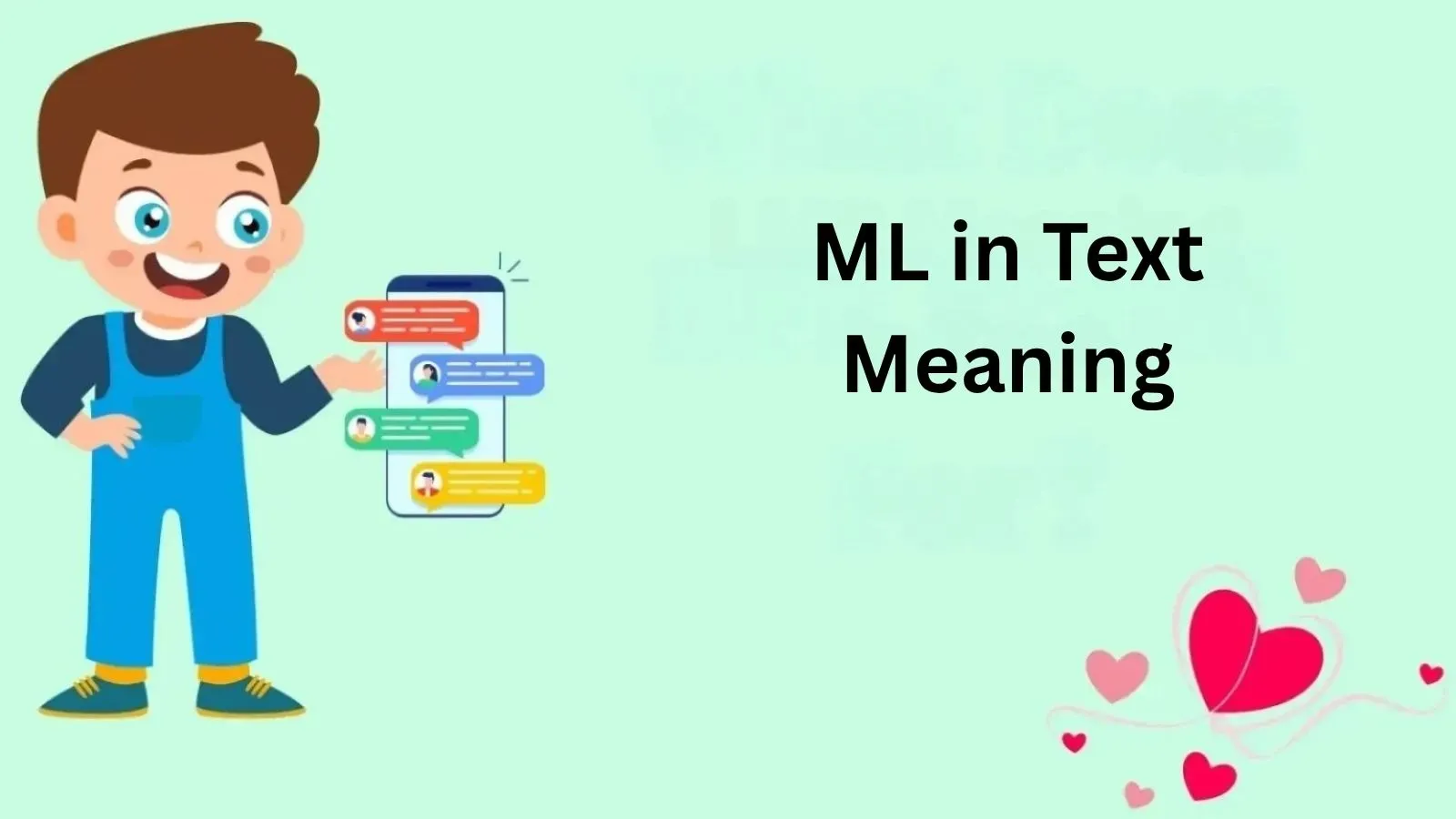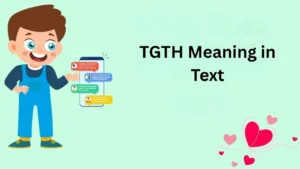Have you ever gotten a text with “ML” and wondered what it means? You’re not alone! In today’s fast-paced world of texting and social media, abbreviations like ML pop up everywhere.
Short for “My Love”, it’s a sweet way to show affection in chats, posts, or even gaming lobbies. People use it to connect quickly, whether flirting on dating apps or joking with friends. Understanding ML helps you keep up with conversations and avoid confusion.
It’s especially common among younger folks on platforms like TikTok, Snapchat, or WhatsApp. Knowing what ML means and when to use it can make your texts feel warmer or save you from an awkward reply.
This blog dives into its meaning, history, and how to use it right in different settings. Let’s explore why ML matters in our digital world!
Definition & Meaning
ML stands for “My Love” in texting and online chats. It’s a quick, affectionate term used to express care, love, or closeness. Think of it as a digital hug! People use it to show fondness without typing out long phrases. It’s casual, sweet, and fits perfectly in short messages.
Key Points:
- ML is an abbreviation for “My Love.”
- It’s used in romantic, friendly, or playful contexts.
- Common in texting, social media, and gaming chats.
Examples in Use:
- Romantic Text: “Hey ML, miss you already! 😘”
- Friendly Chat: “Thanks for the help, ML! You’re the best.”
- Playful Gaming: “ML, you carried that match! 🔥”
These examples show how ML adds warmth to conversations. It’s versatile but works best in informal settings where you’re close to the person.
Background & History
The term ML as “My Love” comes from the rise of texting in the early 2000s. Back then, phones had limited characters (remember those 160-character SMS limits?).
People got creative, shortening phrases to fit. Terms like “babe” or “love” became single letters or short codes like ML. It likely started in English-speaking countries, especially in the UK and US, where “love” is a common endearment.
Key Points:
- ML emerged during the SMS era to save space.
- It gained traction with instant messaging apps like MSN and AIM.
- Today, it’s widespread on platforms like WhatsApp, Snapchat, and TikTok.
Over time, ML evolved from a practical shortcut to a trendy way to show affection. It’s now a staple in Gen Z and Millennial slang, especially in casual or flirty contexts. Its simplicity makes it a go-to for quick, heartfelt messages.
Usage in Various Contexts
ML shines in different situations, from texting to gaming. Its tone depends on the relationship and platform. Here’s how it’s used:
Texting:
- Used between couples, close friends, or family.
- Adds a sweet, personal touch.
- Example:
- Anna: “ML, you free tonight?”
- Jake: “For you, ML, always! 😊”
Social Media:
- Common in comments or DMs on Instagram, TikTok, or Twitter.
- Often paired with emojis for extra flair.
- Example:
- User1: “Your post is fire, ML! 🔥”
- User2: “Haha, thanks ML! 😍”
Gaming:
- Used playfully among teammates or friends.
- Can lighten the mood during intense matches.
- Example:
- Gamer1: “ML, you sniped them all!”
- Gamer2: “Easy, ML, I’m just warming up! 😎”
Casual Conversations:
- Works in relaxed chats to show friendliness.
- Not ideal for strangers, as it implies closeness.
- Example:
- Friend1: “ML, you gotta try this café!”
- Friend2: “Ooh, ML, send me the address!”
ML fits best where warmth and familiarity are welcome. It’s less common in formal or professional settings.
Common Misconceptions & Clarifications
Some people misread ML or assume it means something else. Let’s clear things up.
Misconceptions:
- Machine Learning: In tech circles, ML might mean “machine learning.” Context matters—texts about AI won’t use “My Love”!
- Other Acronyms: Some think ML stands for “Much Love” or “My Life.” While “Much Love” is close, ML typically means “My Love.”
- Inappropriate Contexts: Using ML with strangers or in formal chats can seem too forward or confusing.
Clarifications:
- Check the vibe: If someone uses ML in a flirty or friendly way, they mean “My Love.”
- Tone matters: ML can feel romantic or platonic, depending on the relationship.
- Avoid in professional settings: It’s too casual for emails or work chats.
Example Misunderstanding:
- Techie: “I’m working on ML models all day.”
- Friend: “Wait, you’re calling your computer ‘My Love’?”
- Techie: “Haha, no, machine learning!”
Always consider the context to avoid mix-ups.
Similar Terms & Alternatives
If you’re not feeling ML, there are other ways to show affection. Here are some alternatives:
- Babe/Bae: Common for romantic partners or close friends.
- Hun/Honey: Sweet and versatile, used in many contexts.
- Dear: More formal but still affectionate.
- Sweetie: Playful and friendly, great for casual chats.
Comparison Table:
| Term | Meaning | Best Used In | Tone |
| ML | My Love | Texting, social media | Romantic, friendly |
| Bae | Before Anyone Else | Romantic chats, social media | Very romantic |
| Hun | Honey | Casual, friendly chats | Warm, neutral |
| Dear | Dear | Letters, formal texts | Polite, caring |
These terms vary by tone and relationship. ML is unique for its short, versatile charm.
How to Respond to This Term
Getting an ML in a text? Your reply depends on the vibe you want. Here are options:
Casual Response:
- Keep it light and friendly.
- Example:
- Them: “ML, you coming to the party?”
- You: “Yup, ML, wouldn’t miss it!”
Funny Response:
- Add humor to keep things playful.
- Example:
- Them: “ML, you’re late again!”
- You: “ML, time’s just jealous of our vibe! 😜”
Professional Response:
- If it feels too personal, redirect politely.
- Example:
- Them: “ML, great job on the project!”
- You: “Thanks for the kind words! Appreciate it.”
Privacy-Conscious Response:
- Gently set boundaries if it’s too forward.
- Example:
- Them: “Hey ML, what’s up?”
- You: “Haha, just chilling. What’s good?”
Match the sender’s tone, but stay true to your comfort level.
Regional or Cultural Differences
ML as “My Love” is most common in English-speaking countries like the US, UK, Canada, and Australia. It’s rooted in English endearments, so it’s less common in non-English cultures unless borrowed through social media or pop culture.
Key Points:
- Western cultures: ML is widespread in casual chats, especially among younger people.
- Non-English regions: May not be recognized or used unless influenced by global apps like TikTok.
- Regional slang: In the UK, “love” is a common greeting (e.g., “Alright, love?”), making ML feel natural. In the US, it’s more romantic or flirty.
Examples:
- UK: “ML, fancy a cuppa?” (Friendly, casual)
- US: “ML, you look amazing tonight!” (Romantic)
- Non-English: In Spanish-speaking chats, terms like “cariño” (darling) are more common than ML.
Cultural context shapes how ML lands, so be mindful of local norms.
Comparison with Similar Terms
Here’s how ML stacks up against similar expressions:
| Term | Meaning | Context | Formality |
| ML | My Love | Texting, social media | Informal |
| Bae | Before Anyone Else | Romantic texts, social media | Very informal |
| Love | Love | Casual or romantic chats | Informal |
| Darling | Darling | Romantic or polite settings | Slightly formal |
Key Differences:
- ML is shorter than “Love” or “Darling,” perfect for quick texts.
- Bae feels trendier and more romantic, often used by younger couples.
- Darling can sound old-fashioned or formal in some regions.
Choose based on the platform and your relationship with the person.
Usage in Online Communities & Dating Apps
ML is a hit on platforms like Tinder, Twitter, and gaming communities. It’s a quick way to flirt or bond.
Dating Apps (Tinder, Bumble):
- Used to show interest or affection early in chats.
- Example:
- User1: “ML, your profile pic is cute!”
- User2: “Haha, thanks ML! Yours too!”
Twitter/X:
- Common in replies or DMs to show support or playfulness.
- Example:
- User1: “This song slaps, ML!”
- User2: “Right? ML, you get it! 🎶”
Gaming Communities:
- Used to hype up teammates or joke around.
- Example:
- Player1: “ML, that clutch was insane!”
- Player2: “Haha, ML, just doing my thing!”
Tips for Responding:
- Keep it light and match their energy.
- If flirting on Tinder, use ML back to keep the vibe flirty.
- Avoid overusing it to prevent seeming too forward.
Hidden or Offensive Meanings
ML as “My Love” is generally safe and sweet, but context matters. It has no widely known offensive meanings, but missteps can happen.
Potential Issues:
- Too forward: Using ML with someone you barely know can feel creepy or overly intimate.
- Misinterpretation: In tech-heavy chats, ML might be mistaken for “machine learning.”
- Cultural mismatch: In cultures where endearments aren’t common, ML might seem odd or inappropriate.
Why Tone Matters:
- A playful ML in a gaming chat is fine, but in a work email, it’s a no-go.
- Example:
- Okay: “ML, you killed it in that game!”
- Not Okay: “ML, great job on the report!” (Too personal for work)
Always gauge the relationship and setting before using ML.
Suitability for Professional Communication
ML is not suitable for professional settings. It’s too casual and personal for emails, reports, or workplace chats. Using it risks seeming unprofessional or overly familiar.
Key Points:
- Stick to formal terms like “Dear” or the person’s name in work settings.
- ML works best in personal, informal contexts.
- If you want to show warmth professionally, use polite alternatives.
Professional Alternatives:
- Dear [Name]: Standard for emails or letters.
- Hello [Name]: Neutral and friendly.
- Colleague/Friend: If you know them well but want to keep it professional.
Example:
- Unprofessional: “ML, can you review this document?”
- Professional: “Dear Sarah, can you review this document?”
Save ML for friends, family, or romantic partners, not coworkers or clients.
FAQs
- What does ML mean in texting?
- It means “My Love,” a sweet way to show affection in casual chats.
- Is ML ever offensive?
- Not usually, but it can feel too forward if used with strangers or in formal settings.
- Can ML mean something else?
- In tech, it might mean “machine learning.” Check the context!
- Where is ML most common?
- It’s popular in English-speaking countries, especially in texting and social media.
- How do I reply to ML?
- Match the tone: use “ML” back for flirty or friendly vibes, or keep it neutral if unsure.
- Is ML okay for professional chats?
- No, it’s too casual. Use “Dear” or the person’s name instead.
- Does ML have cultural variations?
- It’s mainly English-based, but similar terms like “cariño” exist in other languages.
Conclusion
ML, or “My Love,” is a small but mighty term in today’s digital world. It’s a quick way to add warmth to texts, social media posts, or gaming chats. From its roots in the SMS era to its popularity on TikTok and Tinder, ML has become a go-to for showing affection.
But it’s not one-size-fits-all—context is everything. Use it with friends or crushes, but steer clear in professional settings. By understanding its vibe, cultural differences, and alternatives like “bae” or “hun,” you can use ML confidently and avoid mix-ups.
So, next time you get an “ML” in a text, you’ll know exactly what it means and how to reply with style. Keep spreading the love, one text at a time!



